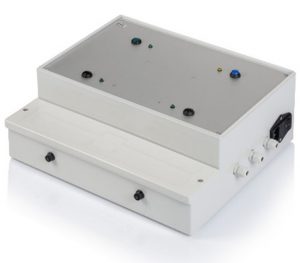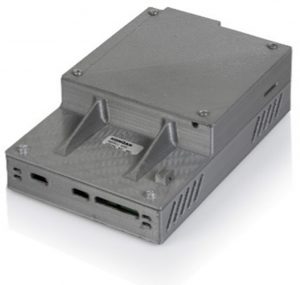Other articles
The main goal of the Safety Vest System (SVS) is to enable the safe cooperation of human workers and machinery. Its initial application is in flexible warehouses equipped with robots (AGVs – Automated Guided Vehicles) and a pre-existing safety system but can easily be extended and adapted for other applications where cooperation of humans and machines is needed or is desirable.
Safety functions of the SVS are
- stopping all machines within a safe distance of the Safety Vest (initiated by safeguard)
- emergency stop of all potentially dangerous machines in the facility (initiated by the user).
SVS can be adapted to implement the emergency stop function in tandem with a different existing safety system or entirely on its own, depending on the structure and requirements of the facility where it is to be deployed.
Safety Vest
The Safety Vest (SV) is a hi-visibility jacket fitted with the SVS electronic ranging system and an emergency stop rip-cord. The SV transmits and receives wireless range-finding signals to nearby machines equipped with the SVS Emergency Stop Module. The ESM unit will safely stop the machine if the worker comes too close. In an emergency, the worker may bring all the dangerous machines in the facility to a stop by pulling the emergency stop rip-cord on the SV. The SV operates from a rechargeable battery pack.


Safety Vest Base Station
The Safety Vest Base Station (SVBS) is a fixed installed unit with the following functions:
- receives Wi-Fi safety heartbeat signals from active SVs
- controls access of workers wearing SVs to and from the warehouse via sluice or light curtain
- provides battery charger functions for up to two SVs when they are not in use.
The SVBS is intended for use by trained workers in a restricted-access industrial work environment.
Emergency Stop Module
 The Emergency Stop Module (EMS) is a wireless transceiver and e-stop unit installed in machines e.g., AGVs and logistics vehicles. It contains the SVS ranging system and transmits and receives wireless range-finding signals to nearby SVs.
The Emergency Stop Module (EMS) is a wireless transceiver and e-stop unit installed in machines e.g., AGVs and logistics vehicles. It contains the SVS ranging system and transmits and receives wireless range-finding signals to nearby SVs.
The ESM will detect and exchange range-finding signals with SVs that are within a radius of 20m or more. The ESM contains two potential-free safety relays that connect into the brake/drive system of the machine for activation of its e-stop function if a worker wearing an SV comes within a configurable safety distance.
SVS components are highly functional prototypes developed with flexibility and (re)configurability in mind. They can and should be configured and optimized for each use-case or application.
How it works
In the initial state, the Safety Vests are connected to the SVBS for charging. When a Safety Vest is unplugged, it initializes and reports to the SVBS. A person can then request entry to the dangerous area by pressing a designated button on the SVBS. If all conditions for safe entrance to the dangerous area are fulfilled, SVBS instructs the facility safety system to open the gate (or light curtain) or does it itself by activating one of its safe outputs. This enables the person to enter the dangerous area without breaking the safety loop and stopping the whole facility.
Once activated, SV partakes in RTOF (Round-Trip Time-Of-Flight) ranging with ESMs in its UWB (Ultra-Wideband) range. It also periodically transmits a message to SVBS indicating correct operation, the so-called SV heartbeat.
If in range of SV’s UWB transmissions, ESM periodically determines its distance to SV. If the measured distance to the SV is below a certain threshold, ESM can instruct the control system of the machine to limit its speed. If the distance is at or below the dangerous limit, ESM initiates a safety stop of the machine. This is shown in the video taken during the testing of the SVS.
During the operation of the SV, after a successful entry procedure has been performed, SVBS expects periodic messages from the SV that indicate its correct operation. If these messages are not received SVBS breaks the safety loop via its safety output and brings the whole facility into a safe state. If a person is in a dangerous area and the SV malfunctions, the only way to ensure the person’s safety is by stopping all the operating machines in that area.
For the next blog post, we will prepare more information about the technology behind the SVS. Follow us for updates…
KONČAR – Electrical Engineering Institute is mainly focused on providing solutions in the area of railway and electric power equipment and systems. However, recognizing the huge potential of the developed technology of Safety Vest System, we are publishing this blog post series to attract partners interested in bringing it to the market.
This work has been supported by the European Union’s Horizon 2020 research and innovation program under grant agreement No. 688117 (SafeLog). SafeLog project consortium was comprised of:
- Karlsruhe Institute of Technology
- Swisslog
- Czech Technical University in Prague
- The University of Zagreb, Faculty of Electrical Engineering and Computing
- Fraunhofer Institute for Material Flow and Logistics
- KONČAR – Electrical Engineering Institute